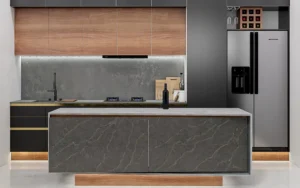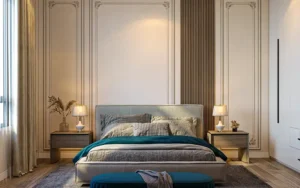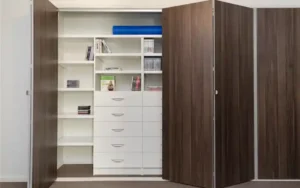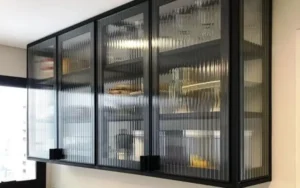What is veneer?
in this article we’ll share all the details about veneer Finish. The most popular finish in interior design field.
Here is the content we will be discussing regarding this finish today. Let’s explore it in detail.
- What is veneer ?
- How its Made?
- Commonly Used places?
- Advantages.
- drawbacks.
let’s dive into the fascinating world of veneers, a material that beautifully marries natural elegance with practicality. Veneers are a designer’s secret weapon when aiming to achieve sophistication and warmth without the expense or environmental impact of using solid wood. Let us walk you through this incredible material, exploring its origins, applications, and why it’s so revered in the interior design world.
What is veneer Finish?
Veneer is a thin layer of natural wood that is sliced or peeled from a tree log. Think of it as the “essence” of a tree, capturing its unique grain, texture, and color. This thin layer is typically applied to a substrate like plywood, MDF, or particleboard to create surfaces that look and feel like solid wood without the associated cost or weight.

Unlike laminates, which are synthetic and printed, veneers bring the natural warmth and authenticity of real wood into your interiors. Each sheet of veneer is unique, carrying the distinctive grain pattern of the tree it came from, making it a prized choice for those seeking natural aesthetics.
- Rotary Cut: The log is peeled in a continuous sheet, similar to unrolling paper. This produces wide, bold patterns that are ideal for plywood and large surfaces.
- Flat Cut (Plain Sliced): The log is sliced in layers parallel to its length, creating a pattern resembling solid wood planks.
- Quarter Cut: The log is sliced at a 90-degree angle to the growth rings, resulting in straight-grain patterns with a refined, linear look.
After cutting, the veneer sheets are dried, graded for quality, and sometimes treated or stained to enhance their appearance. The finished sheets are then bonded to a substrate, creating strong, stable panels.
Where is veneer commonly used in interior design?
Veneers are synonymous with luxury and are commonly used in areas where natural wood aesthetics are desired without the challenges of maintaining solid wood. Here’s where you’ll often find veneers:
Where is acrylic commonly used in interior design?
You will often see acrylic being used in applications like furniture, partition panels and shelving units. It’s also frequently used in lighting fixtures, signage, mirrors, and wall cladding. Acrylic is perfect for creating features in both residential and commercial spaces, from glossy modern kitchen shutters to stunning acrylic wardrobe’s that add a touch of sophistication to any room.
- Furniture: Acrylic is widely used for creating modern and chic furniture pieces. Coffee tables, side tables, and even whole shelving systems made of acrylic can give a space a contemporary and airy feel. It’s a fantastic material for small spaces because it doesn’t visually crowd a room due to its transparency.
- Wall Panels & Partitions: Acrylic wall panels add a sleek and modern touch to spaces. When combined with LED lighting, they can transform an ordinary wall into an eye-catching focal point. Acrylic partitions are also an excellent choice for office interiors, where they offer privacy without blocking light.
- Kitchen: Acrylic kitchens are a beautiful, seamless option for kitchen shutters. They’re not just visually appealing but also resistant to stains and easy to maintain. With options in a range of finishes, from glossy to matte, acrylic is highly customizable to match any design.
- Lighting Fixtures: Acrylic is often used in lighting designs because of its ability to diffuse light beautifully. It can be molded into various shapes and sizes, making it ideal for creating contemporary light fixtures and pendant lights that brighten up any room.
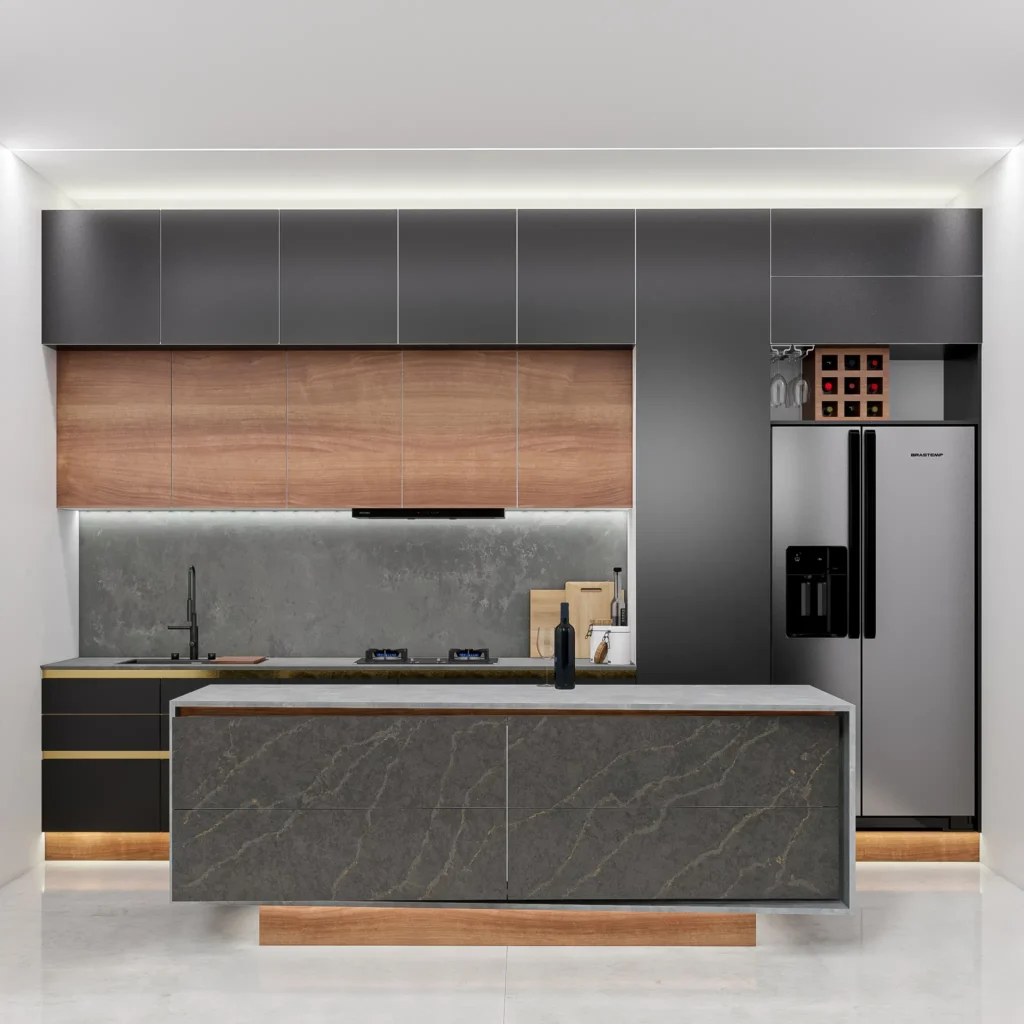
Design Your Dream Kitchen: Explore Our Modular Interior Design Services
Launch Your Modular Kitchen Journey with Align Designs: Find the Best Plywood and Hardware Fittings in Our Curated List.
✔️Free 3D Designs
✔️Color selection
✔️45 Days Deliver
✔️15 years Guarantee
Advantages of Acrylic:
- Clarity & Transparency: One of the most standout qualities of acrylic is its exceptional clarity, which makes it a perfect alternative to glass. Its optical clarity allows light to pass through freely, creating a bright, airy space. Acrylic can also be colored or frosted, providing a range of finishes that can complement any design style.
- Lightweight: Compared to glass, acrylic is much lighter, making it easier to handle and install. This makes it a popular material for furniture and fixtures where weight is a concern.
- Durability: Acrylic is highly resistant to impact and is much less likely to break or shatter compared to glass. This makes it a safer option for spaces with children or in high-traffic areas.
- Easy to Maintain: Acrylic surfaces are easy to clean and maintain. They can be wiped down with a soft cloth and mild soap, making them ideal for kitchens and bathrooms. Unlike glass, they do not require special cleaners to maintain their shine.
But there's some of the drawbacks for acrylic:
- Scratch Sensitivity: While acrylic is resistant to impact, it can be prone to scratches. It’s important to take care when cleaning and maintaining acrylic surfaces. Using the wrong materials or rough cloths can leave marks that may be difficult to remove.
- Heat Sensitivity: Acrylic is sensitive to heat, so placing hot objects directly onto acrylic surfaces can cause deformation or discoloration. This is an important consideration for applications like countertops, where heat-resistant properties are critical.
- UV Degradation: Over time, exposure to sunlight can cause acrylic to yellow or become cloudy. This can be minimized by using UV-resistant acrylic or placing acrylic objects away from direct sunlight.
To conclude, acrylic is an outstanding material in the interior design world. It’s sleek, sophisticated, and incredibly versatile, making it perfect for contemporary, minimalist spaces or for creating statement pieces in more eclectic designs. Its range of finishes, transparency, and ability to be molded into any shape make it a designer’s dream, offering both beauty and function in one package.
So, whether you’re looking to create a striking feature wall, a modern piece of furniture, or a unique lighting fixture, acrylic could be the perfect material to bring your vision to life. Just remember, as with any material, it’s essential to balance its strengths and limitations in your design, ensuring that it complements your overall aesthetic while standing the test of time.

